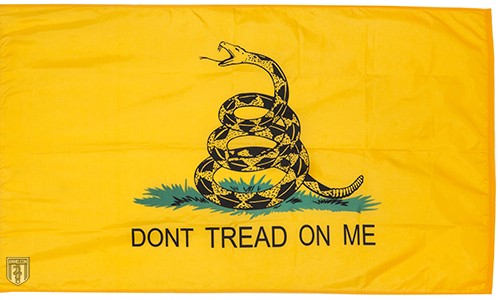
Back in 1751, Benjamin Franklin designed and published America’s first political cartoon. Called “Join Or Die,” it featured a generic snake cut into 13 parts. The imagery was clear: join together or be destroyed by British power. But why a snake? Around this time, Great Britain was sending criminals over to the colonies. Franklin once quipped that the colonists should thank them by sending over shipments of rattlesnakes. As American identity grew, so did an affinity for American (as opposed to British) symbols. Bald eagles, Native Americans and the American timber rattlesnake – the snake depicted on the flag.
By the time 1775 rolled around, the rattlesnake was an immensely popular symbol of America. It could be found throughout the 13 colonies on everything from buttons and badges to paper money and flags. No longer was the snake cut into pieces. It was now recognizably the American timber rattlesnake, coiled into an attack position with 13 rattles on its tail.
The flag takes on a special historical significance at the Battle of Bunker Hill. This battle, still celebrated in Boston, is where Colonel William Prescott famously gave the order not to fire “until you see the whites of their eyes.” One thing the battle underscored was that the Continental forces were woefully low on ammunition. In October of that year, the Continentals learned that two ships filled with weapons and gunpowder were headed for Boston. Four ships were commissioned into the Continental Navy, led by Commodore Esek Hopkins, ordered to get those cargo ships as their first mission.
In addition to sailors, the ships carried marines, enlisted in Philadelphia. Their drummers had drums featuring the yellow of the Gadsden Flag with the now well-known snake emblazoned on top. It included the words Christopher Gadsden was the designer of the flag. He’s known as “the Sam Adams of the South.” Both a soldier and a statesman, Gadsden was a founding member of South Carolina’s Sons of Liberty chapter. He served as a delegate to both the First and Second Continental Congresses. He left the Continental Congress in 1776 to serve as commander of the 1st South Carolina Regiment of the Continental Army. His legislative service continued in the Provincial Congress of South Carolina. And during the war, he was captured and served 42 weeks in solitary confinement after refusing to cut a deal with British expeditionary forces.
After the war, his health was in poor shape, primarily due to his time spent in an old Spanish prison. Gadsden was elected to the position of governor for South Carolina, but declined the position due to his health. He remained in the state legislature until 1788 and voted to ratify the United States Constitution. He died in 1805 and is buried in Charlestown. The Gadsden Purchase in Arizona is named for his grandson, who was a diplomat.
Today you can find the Gadsden Flag and its variations throughout the conservative, libertarian and patriotic movements. The Tea Party waved it during their Obamacare protests in 2009. This is what caught the government’s attention. A 2009 report from Missouri law enforcement called the Gadsden Flag “the most common symbol displayed by right-wing terrorist organizations.” That same year in Louisiana, a man was The Gadsden Flag History: Don't Tread On Me and the Gadsden Flag Meaning originally appeared in the Resistance Library at Ammo.com. Check out The Resistance Library Podcast for more information on The Gadsden Flag History.
